Together
Visual Exploration
Ontario’s Art Collection
In this act of sharing, we find inspiration for our own growth and the growth of our communities.
— Hon. Edith Dumont, Lieutenant Governor of Ontario
Together features 20th and 21st century paintings from the Government of Ontario Art Collection, offering a compelling glimpse into this historic public archive. The exhibition explores a range of themes, techniques, and perspectives, and highlights painters from diverse backgrounds—including Indigenous and Francophone artists—who collectively present a panoramic view of Ontario’s artistic landscape. The artworks are displayed throughout the first floor of the Lieutenant Governor’s Suite, which welcomes dignitaries and guests from across Ontario and around the world. The exhibition’s title suggests the encounters between people, art, and ideas.
Together invites visitors to bring their own perspectives to the work and share their impressions among themselves and with others. As the Honourable Edith Dumont, Lieutenant Governor of Ontario, says: “Art brings us together when words sometimes fail—it unites us across our differences and illuminates the richness of our shared humanity.” Presented by Madame Dumont and reflecting her own interests and sensibilities, Together also foregrounds themes that are close to her heart: our relationship with nature, urban life, social harmony, the beauty of interwoven identities, and, as illustrated by Charles Pachter’s The Painted Flag, the notion of Canadian identity.
Dating back to 1853, the Government of Ontario Art Collection is the oldest public art collection in Canada. It comprises over 2,800 original works, mainly by Ontario artists; they are made accessible to the public through the Art Loan Program, which allows them to be displayed at high-profile locations such as government offices and public areas in government buildings.
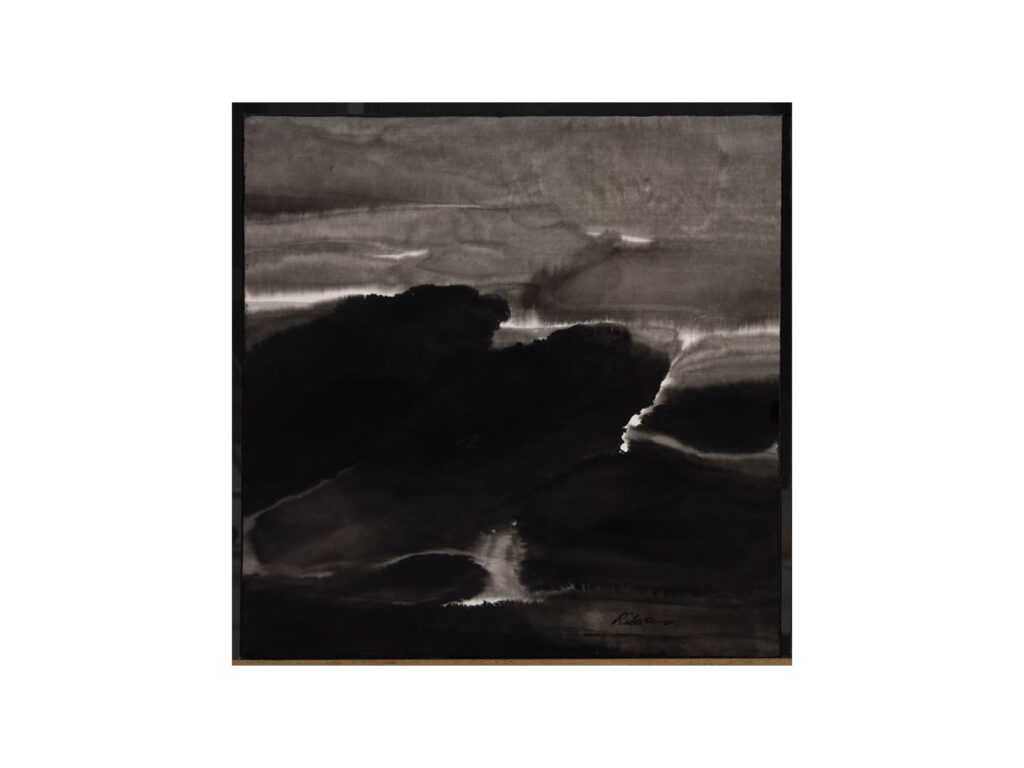
Rita Choy-Ng, (d. 2014)
Don River at Night #2, 2006
Fluid acrylic on paper then canvas
61 x 60.5 cm
Donated by the artist in 2007
Capturing a serene view of the Don River, the piece conveys the river’s natural strength and simplicity through a minimalist palette of black and white.
Note About the Artist: Born in China, Rita Choy-Ng experienced a very diverse education, from Economics at the Lingnan University in Canton, China to Fine Arts at the Ontario College of Art, with much world traveling in between.
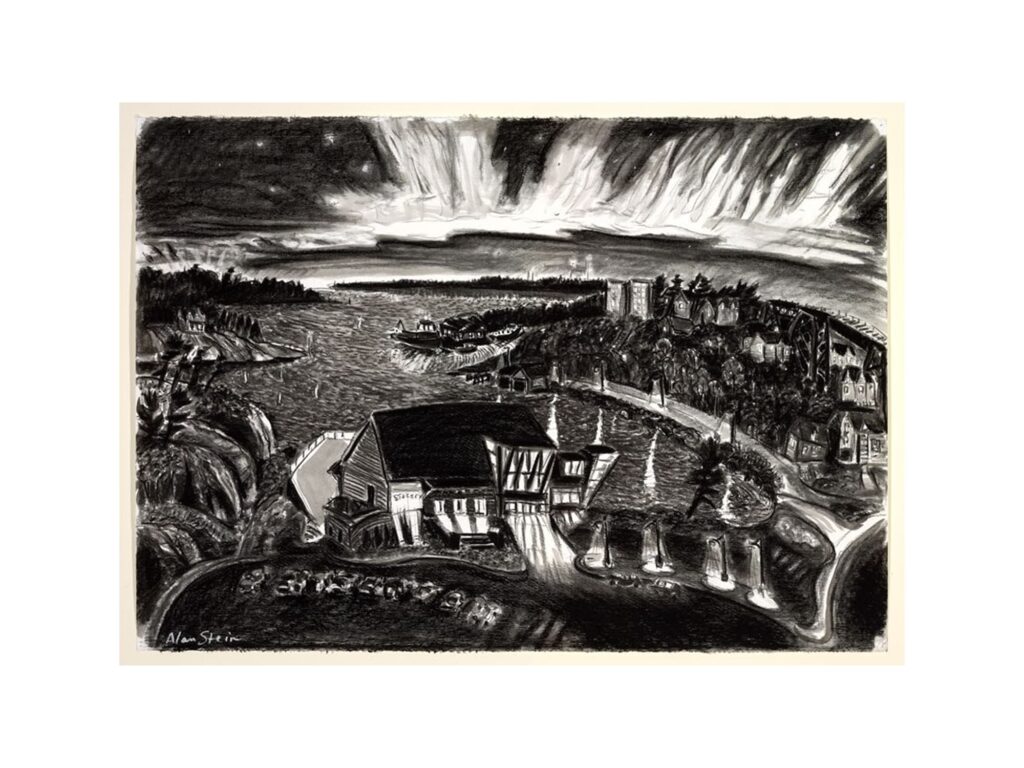
Alan Stein
Opening Night, Parry Sound, 2004
Charcoal on handmade paper
55.6 x 76.2 cm
Donated by the artist in 2007
Featuring constellations, comets and the Northern Lights, this imagined landscape celebrates the Festival of Sound, an annual chamber music festival in Parry Sound.
Note About the Artist: Alan Stein is a painter and printmaker who works primarily with pastel on paper and oil on linen. In 1988, in Parry Sound, he established the Church Street Press in 1998, where he handprints limited edition books with his own illustrations in wood engraving or stone lithography. Much of his work is influenced by summers spent in Georgian Bay, his home in Newfoundland, and his travels. His imagined landscapes, mostly images of night skies, often have spectacular features added, such as constellations, comets and the Northern Lights.
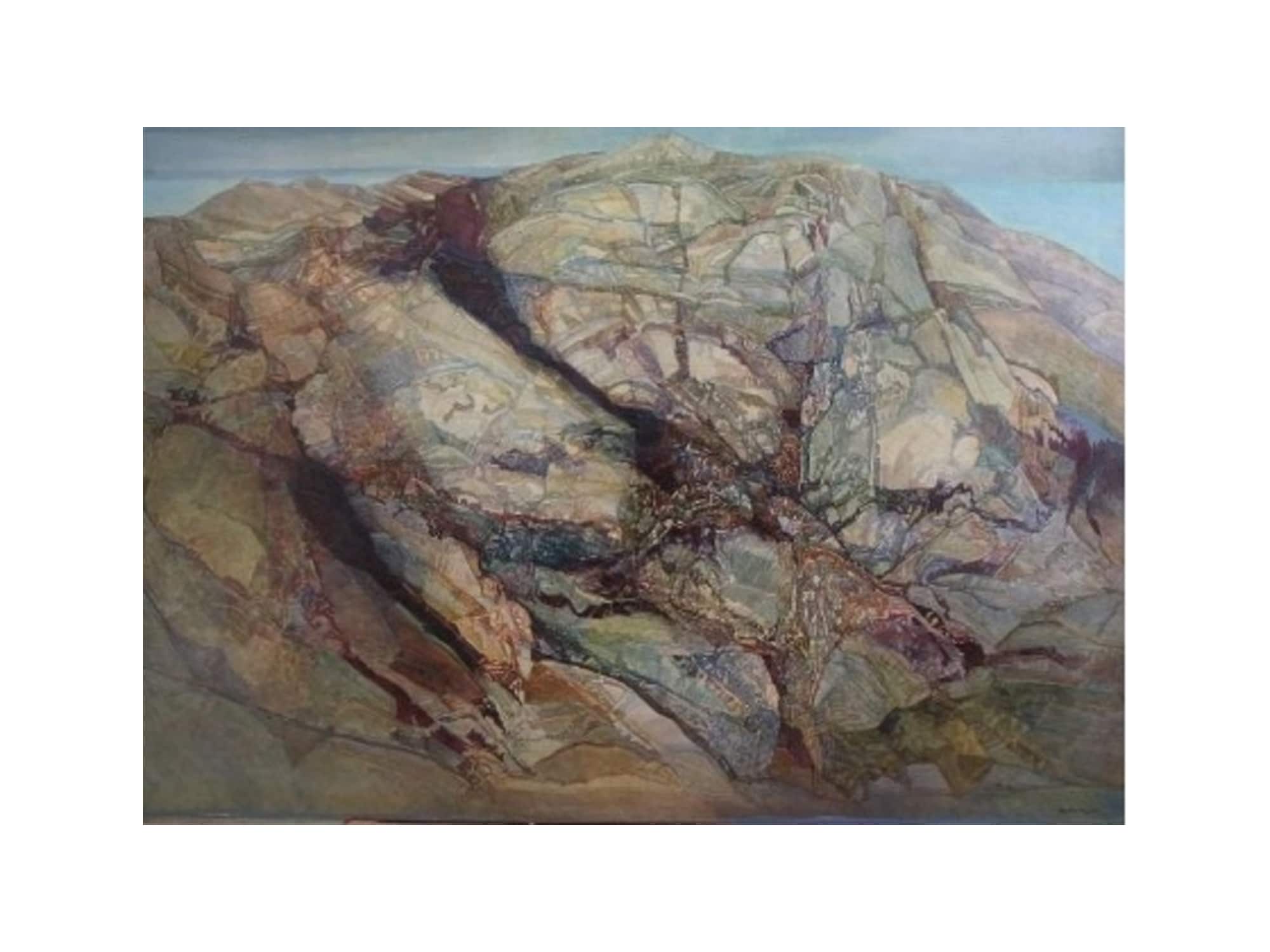
Audrey Elaine Garwood (d. 2004)
Sierra Magic, 1978
Oil on canvas
121.9 x 182.9 cm
Donated by the artist’s family in 2006
Using bold calligraphic style and skillful and subjective use of colour
the artist depicts remote wilderness locations in North and South
America.
Note About the Artist: Audrey Garwood was an accomplished
painter and printmaker. Born in Toronto, Garwood spent much of her life
travelling in search of her subject matter, often to remote wilderness locations
in North and South America. In the early and mid-1950’s she studied art at the
Ontario College of Art, the Rijks Academie in Amsterdam and at La Grand Chaumiere in Paris. She was also the youngest entrant and first woman ever to win the J. W. L. Forster Award of the Ontario Society of Artists. Recognized for her direct and bold calligraphic style of painting and her skillful and subjective use of colour, Garwood’s work is held in numerous private and public collections including the Art Gallery of Hamilton, the Winnipeg Art Gallery and the Robert McLaughlin Gallery in Oshawa.

Christi Belcourt
Tree Spirits Leaving Before the Fire, 2024
Giclée style on fine archival paper
54 x 81.3 cm
Purchased from the artist in 2024
Following the tradition of Métis floral beadwork, the artist paints in dots and uses the subject matter as metaphors for human existence to relay a variety of meanings which include concerns for the environment, biodiversity, spirituality and awareness of Métis culture.
Note About the Artist: Christi Belcourt (apihtâwikosisâniskwêw / mânitow sâkahikanihk) is a visual artist, designer, community organizer, environmentalist, social justice advocate, and avid land-based arts and language learner whose paintings are found within many public and permanent collections across North America. Like generations of Indigenous artists before her, she celebrates the beauty of the natural world while exploring its symbolic properties. Following the tradition of Métis floral beadwork, Belcourt paints in dots and uses the subject matter as metaphors for human existence to relay a variety of meanings which include concerns for the environment, biodiversity, spirituality and awareness of Métis culture.
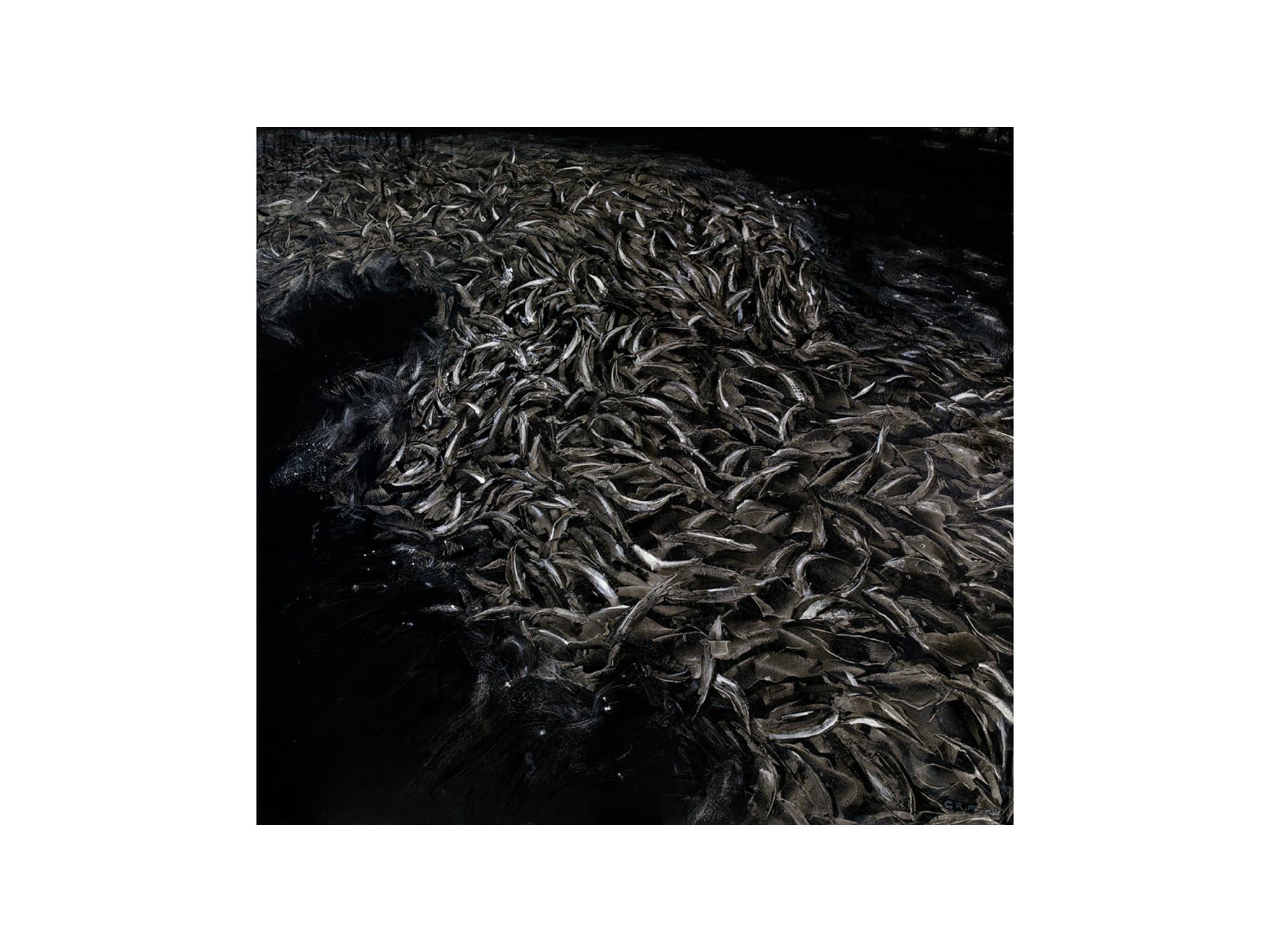
David Griffin
Fry, c. 2003
Oil on wood panel
112.9 x 123 cm
Purchased in 2003
The energy found in the artist’s work is derived from images taken from the natural world. The resulting dynamic of pattern and movement is based, as Griffin notes, on “a rhythmic interplay of muscle and sinew.”
This piece was chosen from the juried exhibition A Celebration of Ontario Artists, held in honour of the 100th anniversary of the Archives of Ontario.
Note About the Artist: David Griffin was born in Kingston, Jamaica, raised in Montreal, and later lived and worked in New York. Stirred by contact with that vast crucible city, he became a painter, achieving a Master of Fine Arts degree at the Pratt Institute. He currently works in Toronto. The energy found in the artist’s work is derived from images taken from the natural world. The resulting dynamic of pattern and movement is based, as Griffin notes, on “a rhythmic interplay of muscle and sinew.” Griffin’s work has been featured in numerous solo and group exhibitions and can be found in private collections in the United States, Canada, Europe, and Africa.
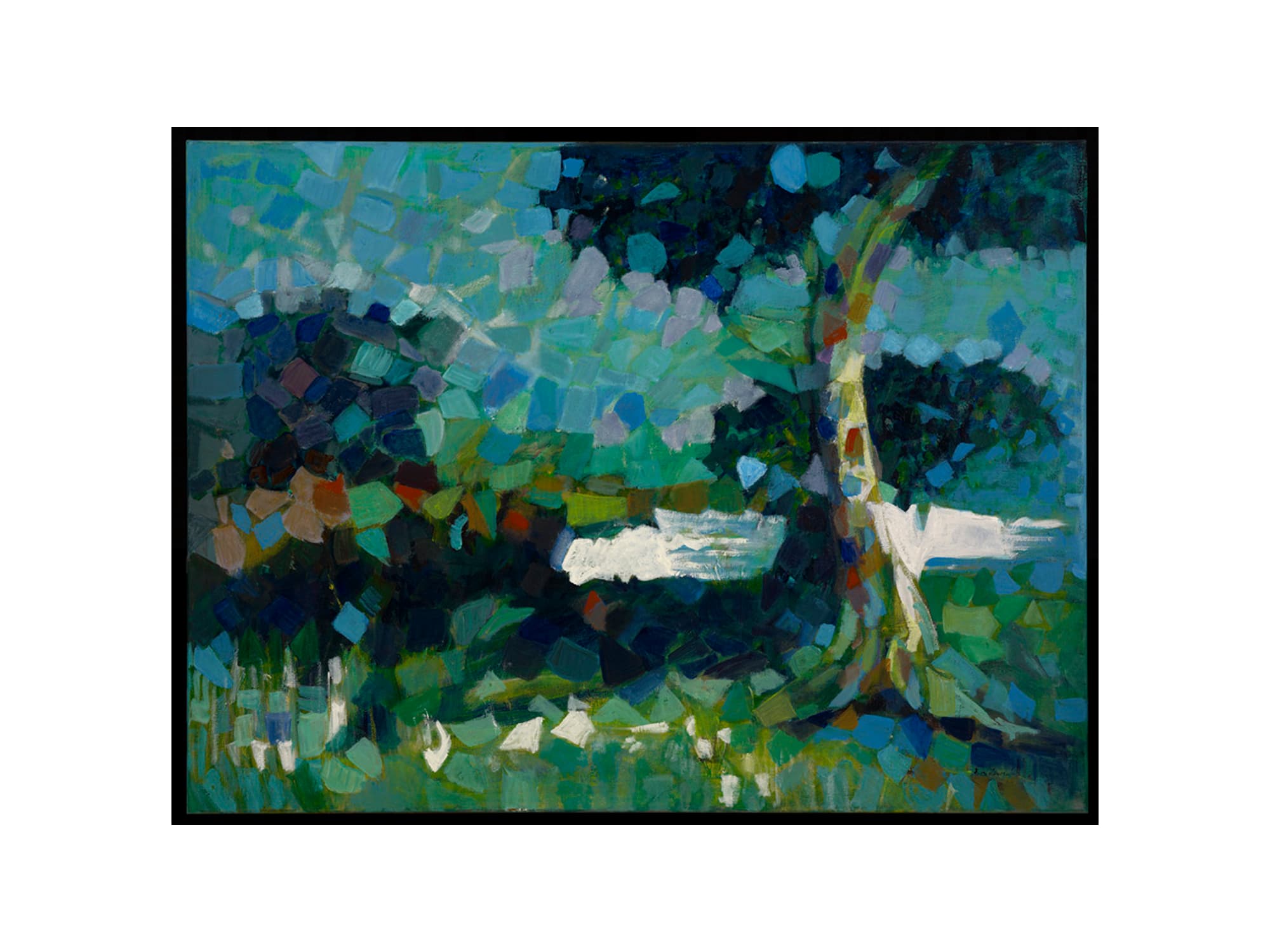
Eva Lewarne
High Park Pond, 2009
Acrylic on canvas
76.2 x 101.6 cm
Donated by the artist in 2011
The Pond is a lovely area in High Park where you can rent row boats and feel like you have gone on vacation while still being in the city. Some people even fish there as the water is clean. The artist used to live near there and would walk or bike ride almost daily, weather permitting.
Note About the Artist: Eva Lewarne was born in Poland but has lived in Toronto for many years. She graduated from the Ontario College of Art and Design after completing her Bachelor of Arts degree with a major in English and Psychology at the University of Toronto. She received a Grand Prix medal in France at a painting festival in Avignon and has had her works shown at the Grand Palais and the Sorbonne in Paris, the Jadite Gallery in New York, and the ACA Gallery, the Art Square Gallery, and the Bezpala Brown Gallery in Toronto.
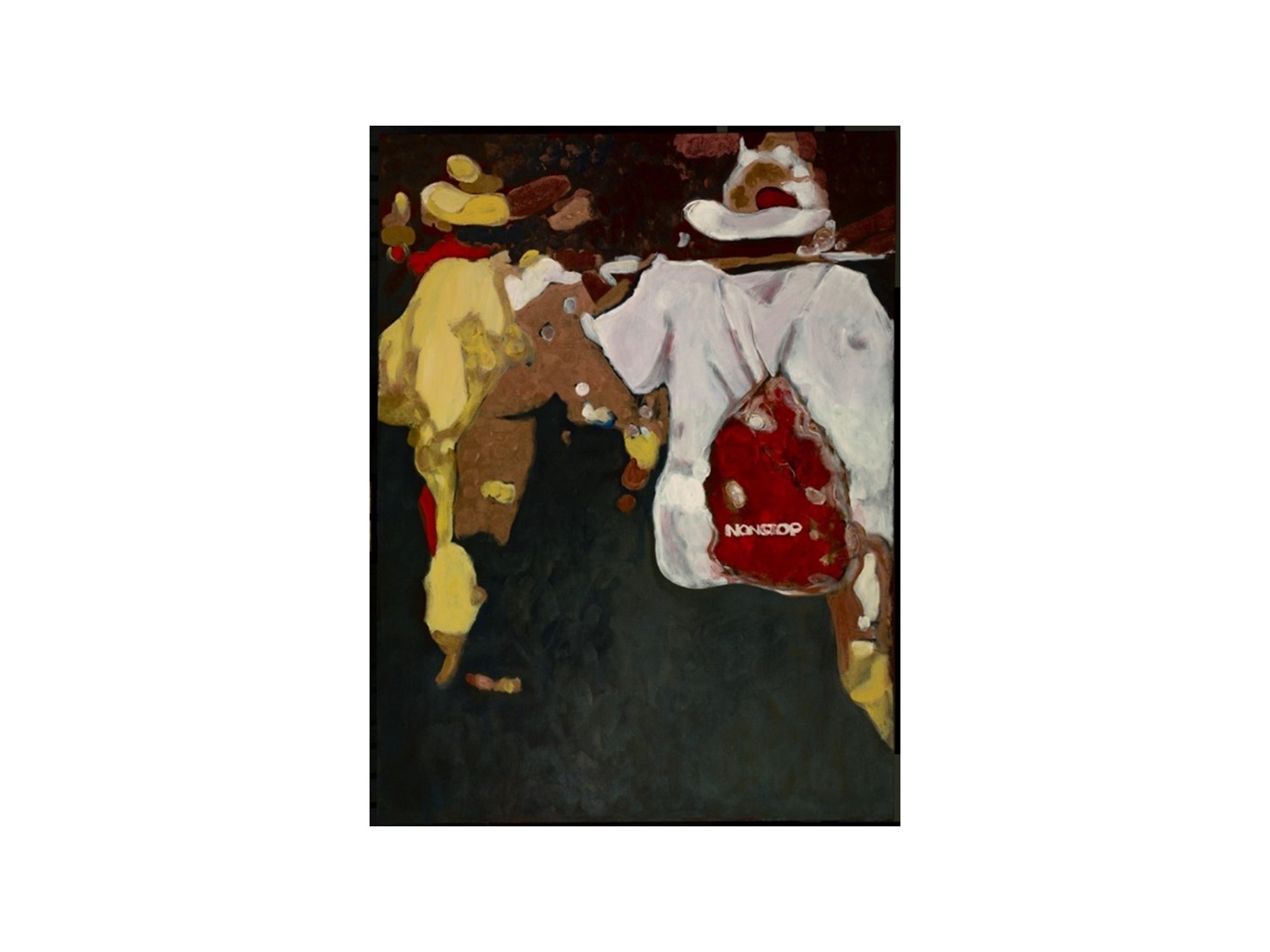
Eva Lewarne
The Travellers, 2011
Acrylic on canvas
122 x 91.4 cm
Donated by the artist in 2011
“Representing a balance between City Life vs Nature, The Travellers are two guys who like to roam and where they land is their home. They were strangers and that is one of the reasons they like to travel, so as not to be settled in any one place.”
– Eva Lewarne
Note About the Artist: Eva Lewarne was born in Poland but has lived in Toronto for many years. She graduated from the Ontario College of Art and Design after completing her Bachelor of Arts degree with a major in English and Psychology at the University of Toronto. She received a Grand Prix medal in France at a painting festival in Avignon and has had her works shown at the Grand Palais and the Sorbonne in Paris, the Jadite Gallery in New York, and the ACA Gallery, Art Square Gallery, and the Bezpala Brown Gallery in Toronto.

Pietro Adamo
Untitled (Apparition Series), 2012
Mixed media on panel
60.9 x 91.4 cm
Purchased in 2014
This painting is an abstract celebration of the artist’s admiration for the “unpredictable and inexhaustible record of life.” He abandons the monotony of conventional rendering of figures through his textured surfaces and rough contours.
Note About the Artist: Pietro Adamo was born in Toronto in 1955. His career as an artist has been a journey of continuous exploration and growth. After graduating from the Fine Art and Art History programs at the University of Toronto and Sheridan College in Oakville, Ontario, he went on to become an art professor at Chaminade College School in Toronto. There he established a strong Visual Arts department. Within two decades, Adamo gained status as an effective teacher while also executing several private and public commissions of his work. By 1997, his work commanded his full-time dedication. Adamo’s paintings are abstract celebrations of the artist’s admiration for the “unpredictable and inexhaustible record of life.” Travel is an important source of inspiration, especially hit trips to his ancestral homeland of Italy. During these extended stays Adamo is able to explore monumental art and architecture as well as the small details of the rural landscape.

Sandra Brewster
Little Girl Dancing 2, 2014
Charcoal on paper
72 x 52 cm
Purchased from the artist in 2015
The artist, born to Guyanese parents, explores identity, representation, and movement in gesture through re-imagined portraits and metaphorical landscapes. Her work reflects the migration of Caribbean people, highlighting a diasporic identity that spans multiple geographies and temporalities.
Note About the Artist: Based in Toronto, Sandra Brewster works in drawing, painting, and mixed-media. Her themes focus on identity and representation, and movement in the depiction of gesture resulting in a re-presentation of the portrait. She uses specific landscapes as metaphors and manipulates old photographs to centre the people within them. Brewster was born to Guyanese parentage, and the Life Series, from which this work is drawn, refers to the migration of Caribbean people from the region, suggesting a formation of identity that encompasses multiple geographies and temporalities, a sense of identity that exists within the diaspora. Recent exhibitions include Musée d’art Rouyn-Noranda (2023), the Museum of Contemporary Art Chicago (2022-23), the Power Plant Contemporary Art Gallery, Toronto (2022), Les Rencontres d’Arles (2022), Hartnett Gallery, Rochester (2022), Art Gallery of Ontario, Toronto (2018-2022), and Or Gallery, Vancouver (2019). Her public sculpture A Place to Put Your Things is on view at the Harbourfront Centre, Toronto.

Sarah Martin
Ski Lesson avec Chevron, 2014
Mixed media on panel
45.7 x 91.4 cm
Purchased in 2015
This work explores the concept of memory. By using vintage photography and painting, the artist explores the way personal and collective memories can respond through a connection to landscape, portraits and seemingly familiar moments in time.
Note About the Artist: Sarah Martin has been a practicing artist for over 20 years, showing her art both nationally and internationally. Her art has been featured multiple times on HGTV shows, was chosen twice for the Princess Margaret Show Home, designed by Brian Gluckstein, and has been highlighted in the magazines House and Home and Style at Home. Her work is in many collections across North America, including the Government of Ontario Art Collection, The County of Simcoe, the Sunshine Banff Resort, the Hythe Hotel in Vail, Colorado; and the Melrose Hotel in Washington, D.C.
![Reaching [Hockley Valley, Ontario], 2017, by Peter Dušek](https://www.lgontario.ca/custom/uploads/2025/05/ac101422.jpg)
Peter Dušek
Reaching [Hockley Valley, Ontario], 2017
Edition 4/10 Archival pigment print
65.4 x 65.4 cm
Donated by the artist in 2020
Young branches from the main tree grow straight up, reaching for the sky. In a chaotic world, it is important to reach for one’s ideals, one’s goals or simply just for excellence.
This work depicts a graphically strong tree on a snowy hill. Neither the tree nor the horizon is level. After some exploration, the eye notices a subtle treeline, barely visible in the distance. Young branches from the main tree grow straight up, reaching for the sky. In a chaotic world, it is important to reach for one’s ideals, one’s goals or simply just for excellence. The snowy lower half contains no ink except for the tree trunk reaching down – leaving the paper bare – as if the tree was painted on a blank canvas.
Artist’s Statement: Peter Dušek is a Canadian photographer whose artwork distills our world to the heart of its essence. Placing a strong emphasis on balance and negative space, and seeking the perfect balance between too much and too little, Peter’s minimalist design goal is “as little as possible, as much as necessary,” giving an abstract quality to his poetic landscapes. His style embodies the Japanese design aesthetic shibumi, which translates as “a quiet elegance.” In this simplicity can be found the serenity and perhaps even the happiness that often eludes us.

Warren Hoyano
Wind Through Pines 2, 2006
Watercolour on paper
76.2 x 55.8 cm
Donated by the artist in 2012
The limited palette, simple mark-making and the aleatory pattern of this watercolour are meant to portray the ephemeral phenomena that we encounter in our everyday existence.
Note About the Artist: Warren Hoyano has lived in Brampton, Ontario for more than 20 years. He is a dedicated watercolourist who works almost exclusively in that medium. Warren has won many awards and has exhibited extensively in both solo and group shows.
![Untitled [Metropolis Reassembled], 2000, by Germinio Pio Politi](https://www.lgontario.ca/custom/uploads/2025/05/ac100425.jpg)
Germinio Pio Politi
Untitled [Metropolis Reassembled], 2000
Mixed media, fresco on board
19.5 x 51 cm
Donated by the artist in 2007
Constructed in gesso on wood and restrained to a monochrome grey-blue, this work interrogates the city not as a specific place, but as a conceptual artifact of modernity. The composition—rigid yet uneasy, ordered yet imprecise—reflects the tension between planned structure and the chaotic assemblage of lived urban experience.
Here, architecture becomes a cipher: a formal vocabulary through which the artist explores fragmentation, repetition, and the failure of representation to fully contain the complexity of collective life. What appears minimal is, in fact, dense with contradiction—a visual essay on the dissonance between the ideal city and its reconstructed image.
Note About the Artist: Born in Brindisi, Italy in 1953, Germinio Pio Politi moved to Canada in 1980. He studied in Taranto, Italy at the Institute “Lisippo” where he graduated in Artistic Oriented Studies (1971). He has been a member of The Ontario Society of Artists since 2006. The artist has shown his work in various group exhibitions at Kipling Gallery, Woodbridge; Joseph D. Carrier Art Gallery and Studio 119, Toronto; Glenhyrst Gallery of Brant, Brantford, Ontario; and the New York Art Expo, among others.

Carol Westcott
North Channel Spring, 2010
Acrylic on canvas
45.7 x 45.7 cm
Donated by the artist in 2020
Inspired by the rugged landscape north of Georgian Bay, North Channel Spring resulted from a late spring trip to the Elliot Lake area of Ontario. Early spring growth mixed with late winter snow provided the impetus for this image, which captures the essence of the region and the time of year in a slightly abstracted view.
Note About the Artist: Heavily influenced by her early life in rural Ontario, Carol Westcott is a contemporary landscape painter utilizing acrylic and mixed media to depict natural and built environments. “Growing up in rural Ontario gave me an early appreciation for the land and its vagaries so, from a very young age, I was inspired by the landscape that I now present in my images,” says Westcott.
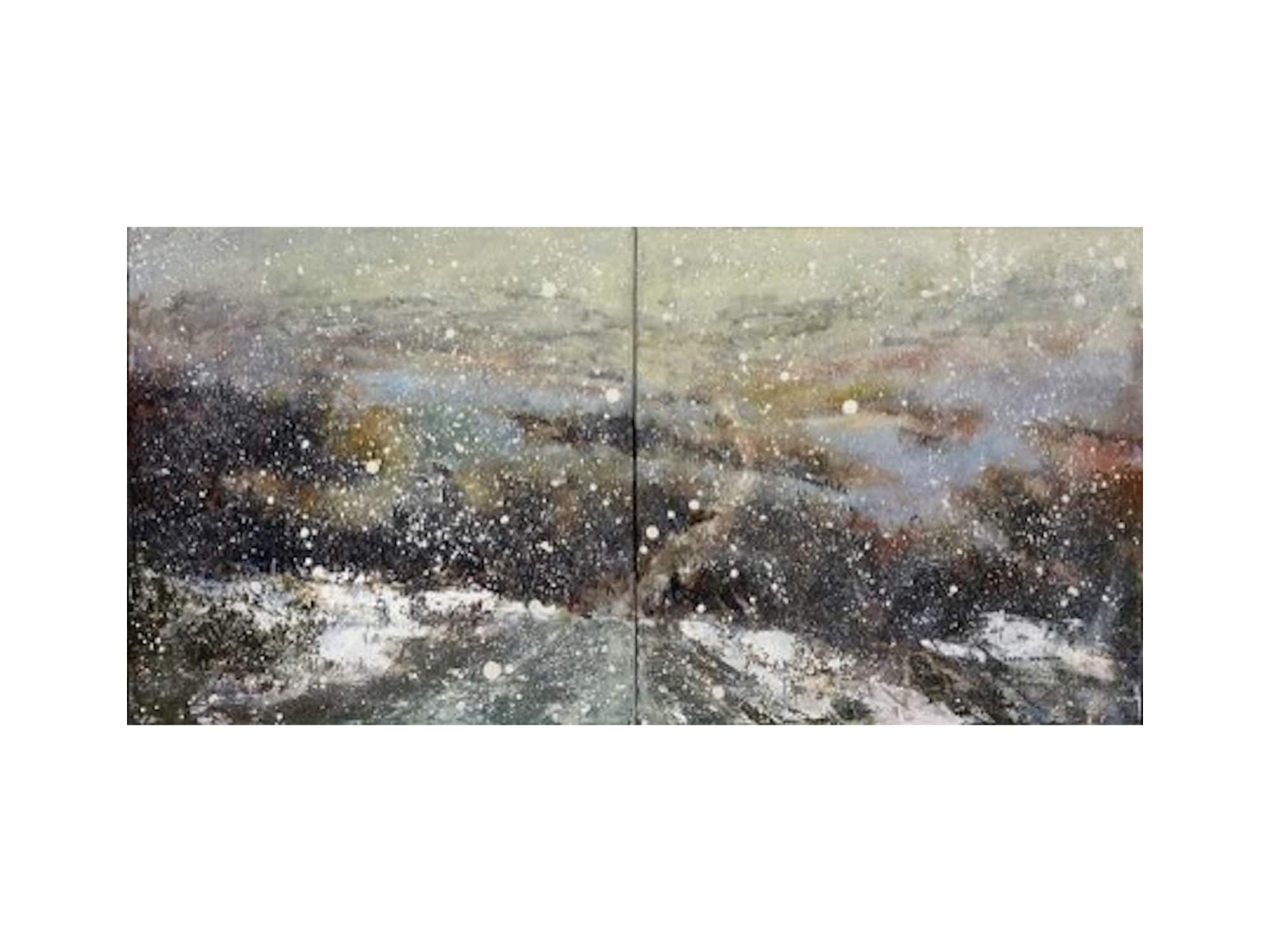
Carol Westcott
Bare to Centre-Bare, 2010
Acrylic on canvas
40.6 x 81.2 cm
Purchased in 2014
“Winter road conditions in rural Ontario inspired this painting. The combination of a gentle snowfall, the rugged natural landscape and a roadway partially covered in snow and ice are quintessential components of the season that we love to talk about, even complain about. Yet winter is a wonderful and beautiful time of year which I have chosen to depict in this slightly abstracted image of the Ontario landscape.”
– Carol Westcott
Note About the Artist: Heavily influenced by her early life in rural Ontario, Carol Westcott is a contemporary landscape painter utilizing acrylic and mixed media to depict natural and built environments. “Growing up in rural Ontario gave me an early appreciation for the land and its vagaries so, from a very young age, I was inspired by the landscape that I now present in my images,” says Westcott.

Diana Harding Tucker (d. 2022)
Approach of Winter, 2020
Pigment print on Hahnemuhle Rag, pastels, & watercolour
41.15 x 96.52 cm
Donated by the artist’s estate in 2024
This work remains a memory of a special day. The artist was a president of the Ontario Society of Artists.
Note About the Artist: Diana Harding Tucker was a musician, award-winning photographer, and mixed media artist. Her early life in Montreal and at the family farm in Knowlton formed her love for nature, and her works often texture realism with mystic colours and form. Her work can be found in Canadian and international collections including the Archives of Ontario. She was a president of the Ontario Society of Artists, a director of the South Simcoe Arts Council, and a member of SOCAN (Society of Composers, Authors and Music Publishers).

Shannon Craig Morphew
Bruce Trail Rocks, 2013
Oil on canvas
101.6 x 101.6cm
Purchased in 2014
The artist’s highly energetic and linear style, influenced by her travels through Canada and Europe, has shaped a vibrant and personal vision. Her distinctive approach is characterized by the dynamic use of ink, oil paint washes, and thick strokes of colour.
Note About the Artist: Shannon Craig Morphew was born in St. John’s, Newfoundland in 1977. There she was first influenced by the raw beauty of the Canadian landscape. She was also influenced by her father, fellow painter Philip Craig, and an early love of art led to courses at Sheridan College and then the Ontario College of Art and Design, where she earned her Bachelor of Fine Arts in 2001. Her landscapes, figures, and still-lifes are all interpreted in the highly energetic and linear style for which Craig Morphew has become well known. Travelling extensively in Canada and internationally has enriched her experience and helped her create a personal and vibrant vision. Craig Morphew’s use of ink, paint washes and thick strokes of colour are characteristic of her approach to painting. She currently resides in Ottawa and exhibits at solo shows in galleries across Canada.

Christi Belcourt
I Envy Their Freedom, 2024
Giclée style on fine archival paper
50.8 x 50.8 cm
Purchased from the artist in 2024
Following the tradition of Métis floral beadwork, the artist paints in dots and uses the subject matter as metaphors for human existence to relay a variety of meanings which include concerns for the environment, biodiversity, spirituality and awareness of Métis culture.
Note About the Artist: Christi Belcourt (apihtâwikosisâniskwêw / mânitow sâkahikanihk) is a visual artist, designer, community organizer, environmentalist, social justice advocate, and avid land-based arts and language learner whose paintings are found within many public and permanent collections across North America.
Like generations of Indigenous artists before her, she celebrates the beauty of the natural world while exploring its symbolic properties. Following the tradition of Métis floral beadwork, Belcourt paints in dots and uses the subject matter as metaphors for human existence to relay a variety of meanings which include concerns for the environment, biodiversity, spirituality and awareness of Métis culture.

Janet Hendershot
Lake Storm No. 5, 2017
Acrylic and polymers on canvas
35.6 x 40.6 cm
Donated by the artist in 2020
Lake Ontario and the lake storms have been a source for many of the artist’s paintings, including Lake Storm No. 5.
Note About the Artist: Janet Hendershot’s paintings have been exhibited across Canada, as well as Mexico, Colombia, London, England, and Paris, France. Her works represented Canada in a group exhibit at the 1976 Olympics. They can also be found in private collections of respected collectors and companies as well as in public collections including Art Bank, The Robert McLaughlin Gallery, The Gallery Stratford, University of Toronto Collections, McGibbon Centre, Baycrest Centre, and the Archives of Ontario.
Hendershot served as president of the Ontario Society of Artists receiving the OSA President’s Award for Service and artistic merit in 2013 and continued to actively contribute to the art community as an active member of the board of the John B. Aird Gallery, Toronto as well as the Ontario Society of Artists. In 2017, she received the Eleanor Besen Financial Award for her work as a professional artist and her contributions to the art community.
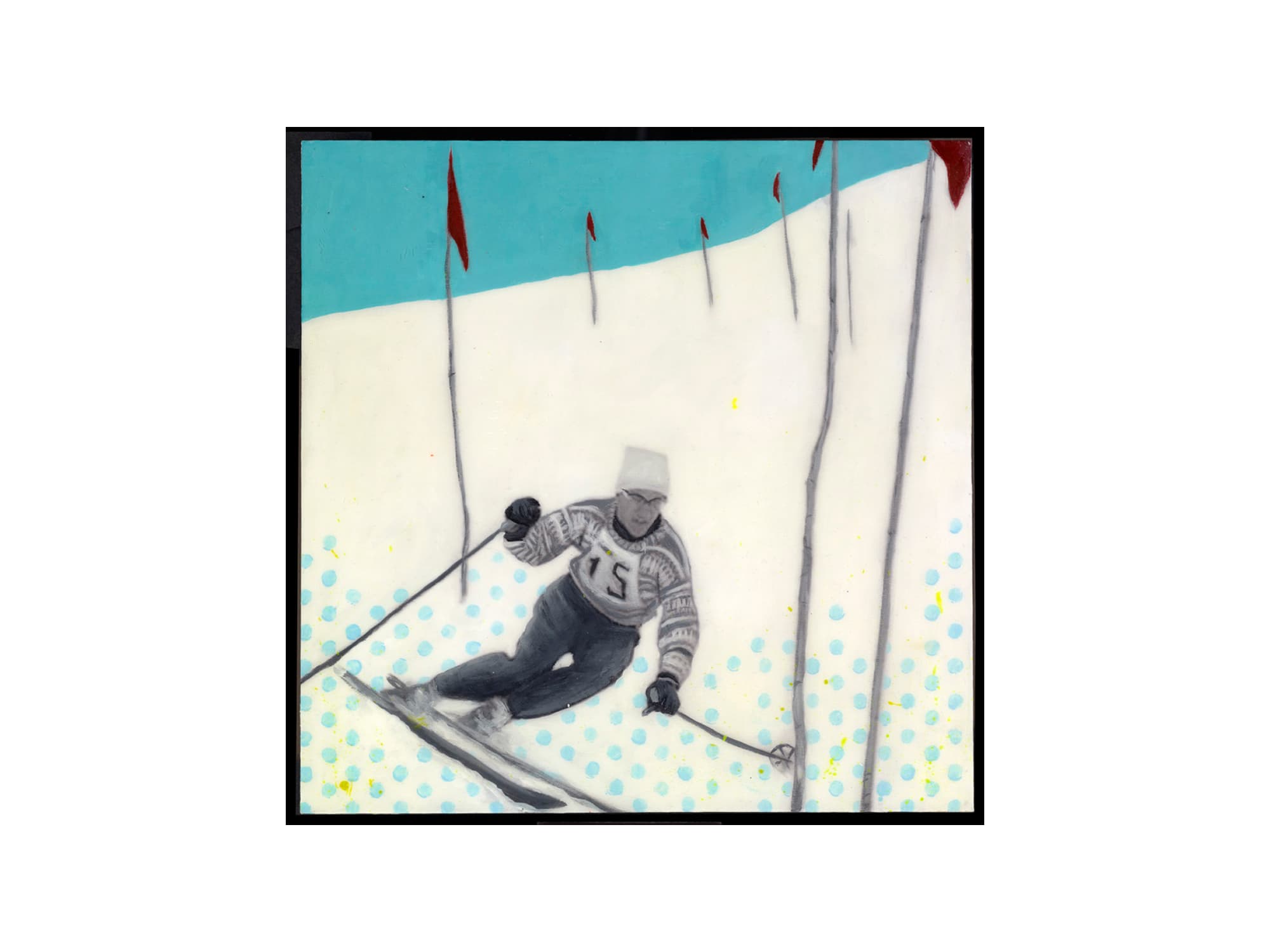
Sarah Martin
Going for the Win, 2014
Mixed media on panel
30.5 x 30.5 cm
Purchased in 2015
This work explores the concept of memory. By using vintage photography and painting the artist explores the way personal and collective memories can respond through a connection to landscape, portraits and seemingly familiar moments in time.
Note About the Artist: Sarah Martin has been a practicing artist for over 20 years, showing her art both nationally and internationally. Her art has been featured multiple times on HGTV shows, was chosen twice for the Princess Margaret Show Home (designed by Brian Gluckstein), and has been highlighted in House and Home and Style at Home magazines. Her work is in many collections across North America, including the County of Simcoe, the Sunshine Banff Resort; the Hythe Hotel in Vail Colorado; and the Melrose Hotel in Washington D.C.

Sarah Martin
Two for the Black Diamond, 2014
Mixed media on panel
30.5 x 30.5 cm
This work explores the concept of memory. By using vintage photography and painting the artist explores the way personal and collective memories can respond through a connection to landscape, portraits, and seemingly familiar moments in time.
Note About the Artist: Sarah Martin has been a practicing artist for over 20 years, showing her art both nationally and internationally. Her art has been featured multiple times on HGTV shows, was chosen twice for the Princess Margaret Show Home (designed by Brian Gluckstein), and has been highlighted in House and Home and Style at Home magazines. Her work is in many collections across North America, including the County of Simcoe; Sunshine Banff Resort; the Hythe Hotel in Vail, Colorado; and the Melrose Hotel in Washington D.C.

Jalani Morgan
9 Bats, 2019
Photograph: inkjet print mounted on dibond
81.3 x 121.9 cm
Purchased from the artist in 2024
At his childhood baseball diamond in Scarborough Village Park, the artist captures moments of strategy, prowess, and creativity through his lens. By “ficto-historicizing,” he aims to provide representation for Black communities, enabling them to see themselves engaging fully with the world.
Artist Statement: Jalani Morgan describes baseball as his first love, and 9 Bats as his love letter. 9 Bats is the first inning of what will be a nine-inning body of work. Morgan’s past projects, including the Black Canadian Baseball Hall of Fame engage the process of not only remembering, or memorializing Canadian Black baseball greats of the 1930s and 40s, but of actively unforgetting a history that has barely been recorded. His intent in documenting and filling in gaps by ficto-historicizing is to provide content and representation for Black communities, that they might better see themselves engaging fully with the world. With 9 Bats, Morgan collaborated with his five-year old nephew Cordell, to embody the character of Devon C. Jones, a young player destined for greatness.
The large-scale installation and photographs in 9 Bats are set at Scarborough Village Park, Morgan’s childhood baseball diamond, with its characteristic suburban skyline and apartments in the background, alluding to time, place, and the many stories unfolding in the surrounding neighbourhood. Young Devon has been gifted a bat that contains magical properties. Representing past, present, and future, Jones owns the field with the bestowed bat, and his natural ability. Through his lens, Morgan has captured moments of strategy, prowess, reflection, and creativity, achieved through motor and sensory impulses, and the assurance of being seen.
Playful, yet inherently political, 9 Bats demonstrates Morgan’s photographic acumen as he touches upon the auto-biographical and fantastical to both represent and continue to build a world where kids like Devon/Cordell engage at the centre, and not on the margins.

Thomas Sinclair
The Life Cycle of the Moose
Acrylic on canvas
121 x 56.75 cm
Purchased in 2024
A Turtle Clan member from Couchiching First Nation in Treaty 3 territory, the artist conveys the legends of his people through reinterpretations of ancient pictographs and petroglyphs. Trained in Woodland art symbolism by Isadore Wadow, Sinclair is a traditional knowledge keeper, preserving cultural heritage through his art.
Note About the Artist: Thomas Sinclair (Miiskwaabiik Maadjikawis) is Turtle Clan, and a member of Couchiching First Nation in Treaty 3 territory of Northwestern Ontario. He is a traditional knowledge keeper and tells the legends of his people through reinterpretations of ancient pictographs and petroglyphs scattered throughout the Ontario wilderness.
Internationally, he has contributed to International Contemporary Art Fairs in Venice, Italy; Innsbruck, Austria; Brussels, Belgium; Madrid, Spain; and London, England. He is also co organizer and co-curator of the Tisiget Indigenous Art Project which helps showcase Indigenous artists in larger art markets in Canada.

Robin Hesse
Dark Sky Moon, 2010
Charcoal and graphite on paper
45.7 x 45.7 cm
Donated by the artist in 2012
The artist draws largely on locations in designated “Dark Sky” areas throughout Ontario, using a telescope to observe stars, the moon or celestial events which become the subjects of her composition.
Artist’s Statement: My work is about the poetry and drama of the sky at night. Stars are born and die. Moons never cede from their planets, the earth is called “mother” and the suns are classed as “dwarfs” or “giants”. The night sky can be seen as a backdrop for human emotion, and therefore is a fascinating metaphor, with stars, planets, moons and other celestial entities mirroring human behaviour.
I draw largely on location in designated “Dark Sky” areas throughout Ontario, and I use a telescope to observe stars, the moon or celestial events which become the subjects of my composition. As astronomers assign acronyms and numbers to newly discovered stars and planets and other celestial bodies so that they may be easily identified, I use a similar system to catalogue my drawings, including in some cases, a mnemonic name for each one.
The night sky poses many challenges to human understanding and our place in the universe.Through my drawings, I hope to express the unanswered questions reflected therein.

Maya Foltyn
Quietude, 2011
Acrylic, pastel, sand on panel
44.2 x 190 cm
Donated by the artist in 2012
Reflecting a dream-like image, taken from a distant memory, this work “represents a stillness of state-of-mind before impending change, but an inability to say exactly what it will bring. The key element is light.”
Artist’s Statement: In the series “Quietude”, my abstract landscapes reflect a dream-like image, taken from a distant memory. It represents a stillness of state-of-mind before impending change, but an inability to say exactly what it will bring. The key element is light. I used a reduced palette, giving priority to diversified shimmering effects. While making lines more abstract, I apply layers of paint using multiple transparencies, combining soft matte surfaces with a wide variety of light-reflective paints over a textured background. The paintings seem to float on the wall and luminously add an ever-changing quality as the light travels around them.

Charmaine Lurch
Fruition, 2009
Acrylic and wire on canvas
91.44 x 121.92 cm
Purchased from the artist in 2018
The artist’s painting and wire relief work bring the indelible presence of Black Canada into view. They map habitation and embody a simple yet complex sense of being and belonging. The young man expresses movement and emotion, allowing us to know this presence as active and agentive.
Artist’s Statement: This paint-and-wire relief work brings the indelible presence of Black Canada into view. It maps habitation and embodies a simple yet complex sense of being and belonging. The young man expresses movement and emotion, allowing us to know this presence as active and agentive. Positioned at leisure, at play, and in studied practice, he simultaneously counters fixed notions of Blackness while calling attention to the specificity of race. These moments without contestation form beats and interruption into a phrase of being belonging and grace.
Note About the Artist: Charmaine Lurch is an award-winning arts researcher and interdisciplinary artist. Her contribution to Canadian art has been influenced by a wealth of cultural experiences, academic studies, and formal art education. Charmaine’s present research involves an examination of how anti-Black racism creates a climate of invisibility and erasure of the experiences and agency of racially marked subjects in society.
Charmaine has her Master’s in Environmental Studies from York University, is a graduate of Sheridan College’s Arts & Design program, and studied at the Ontario College of Arts & Design and the School of Visual Arts in New York City. Her work has been exhibited at a number of galleries, spaces and events, including the Royal Ontario Museum, Scotiabank Nuit Blanche, the University of British Columbia, and the National Gallery of Jamaica. Most notable is her work with Inner City Angels, an art education charity bringing innovative approaches and awareness around social justice and environmental issues to Toronto schools.

Joshim Kakegamic (d. 1993)
Demolish AP VI/VII, 1977
Serigraph
38.1 x 52.7 cm
Purchased from the artist in 1977
Joshim Kakegamic, born in Sandy Lake, Ontario in 1952, began painting under the guidance of Norval Morrisseau and Carl Ray. After discovering screen printing at Fanshawe College, he established a high-quality screen printing business from 1973 to the early 1980s, promoting artistic control and self-representation for Indigenous artists.
Note About the Artist: Joshim Kakegamic (1952-1993) was born at Sandy Lake, Ontario. He began painting as a teenager in the late sixties under the guidance of his Ojibwa brother-in law, Norval Morrisseau, and Cree artist Carl Ray who were holding workshops on local reserves at the time. In 1969, he participated in a group show in North Bay followed by a series of shows in various venues in northwestern Ontario. He continued to paint in North Bay for two years before returning to Sandy Lake.
Shortly after, Josh enrolled in a month-long workshop at Fanshawe College in London, Ontario. He was introduced to the possibilities provided by screen printing, and it was the inspiration he needed to take a serious look at how he and others could make a living as artists. By 1973, with the help of his brothers Goyce and Henry and his father, David, he established a screen-printing business known as the Triple K Cooperative. It was modeled after a company artist Daphne Odjig had set up in 1970 – Indian Prints of Canada Ltd.
His work is in private and public collections in Canada and abroad, including the Simon Fraser University Art Collection, the McMichael Canadian Collection and The Royal Ontario Museum.

Joshim Kakegamic (d. 1993)
Conjurors AP II/III, 1975
Serigraph
76.2 x 55.9 cm
Purchased from the artist in 1977
Joshim Kakegamic, born in Sandy Lake, Ontario in 1952, began painting under the guidance of Norval Morrisseau and Carl Ray. After discovering screen printing at Fanshawe College, he established a high-quality screen printing business from 1973 to the early 1980s, promoting artistic control and self-representation for Indigenous artists.
Note About the Artist: Joshim Kakegamic (1952-1993) was born at Sandy Lake, Ontario. He began painting as a teenager in the late sixties under the guidance of his Ojibwa brother-in law, Norval Morrisseau, and Cree artist Carl Ray, who were holding workshops on local reserves at the time. In 1969, he participated in a group show in North Bay followed by a series of shows in various venues in northwestern Ontario. He continued to paint in North Bay for two years before returning to Sandy Lake.
Shortly after, Josh enrolled in a month-long workshop at Fanshawe College in London, Ontario. He was introduced to the possibilities provided by screen printing, and it was the inspiration he needed to take a serious look at how he and others could make a living as artists. By 1973, with the help of his brothers Goyce and Henry and his father, David, he established a screen-printing business known as the Triple K Cooperative. It was modeled after a company artist Daphne Odjig had set up in 1970 – Indian Prints of Canada Ltd.
His work is in private and public collections in Canada and abroad, including the Simon Fraser University Art Collection, the McMichael Canadian Collection, and The Royal Ontario Museum.

Mique Michelle
Dilo, 2021
Mixed media, graffiti
137.16 x 243.84 cm
Dilo reclaims Indigenous names for the Great Lakes, urging us to recognize the power of naming through oral knowledge from community members. Her mural, with pastel land contours contrasting deep blue lakes, memorializes the métissage of land and language, transcending graffiti’s urban roots.
This piece, a blend of ink, pencil, and paint on paper, showcases Mique Michelle’s mastery in graffiti art, globally recognized for its power and vibrancy. Expanding and extending the power of tagging, Mique Michelle’s Dilo returns to the Indigenous names for what are called the Great Lakes today. Michelle asks, “How can we be allies or protect the water when we call it by its taken name?” in this piece, diverging from graffiti’s deeply urban roots, Michelle visually urges us to witness the power of naming and renaming by seeking and applying oral knowledge from community members Gary Martin, Kristin Murray, Gerry Brandon and Sophie McKeown. Her abstraction contours these bodies of water by representing the land in assortment of light pastel colours—pink, yellow, green and orange—to contrast with the deep blue of the lakes. She captures what she calls “the overlapping, the métissage of land and language,” transforming the mural as a memorial to Indigenous names and knowledge that came before the urban landscapes that structure the possibilities of graffiti.
This statement was written by Mark V. Campbell, who curated the 2022 Canada Council for the Arts exhibition Still Tho: Aesthetic Survival in Hip-Hop’s Visual Art, in which this work appeared.
Note About the Artist: Mique Michelle is a Franco-Ontarienne, originally from West Nipissing. She uses graffiti to create awareness about the oppression that visible and invisible minorities face. She is convinced that murals, just like all elements of hip-hop, can offer solutions to stop the discrimination. Her northern love and roots can be found throughout in her subjects and colour scheme.
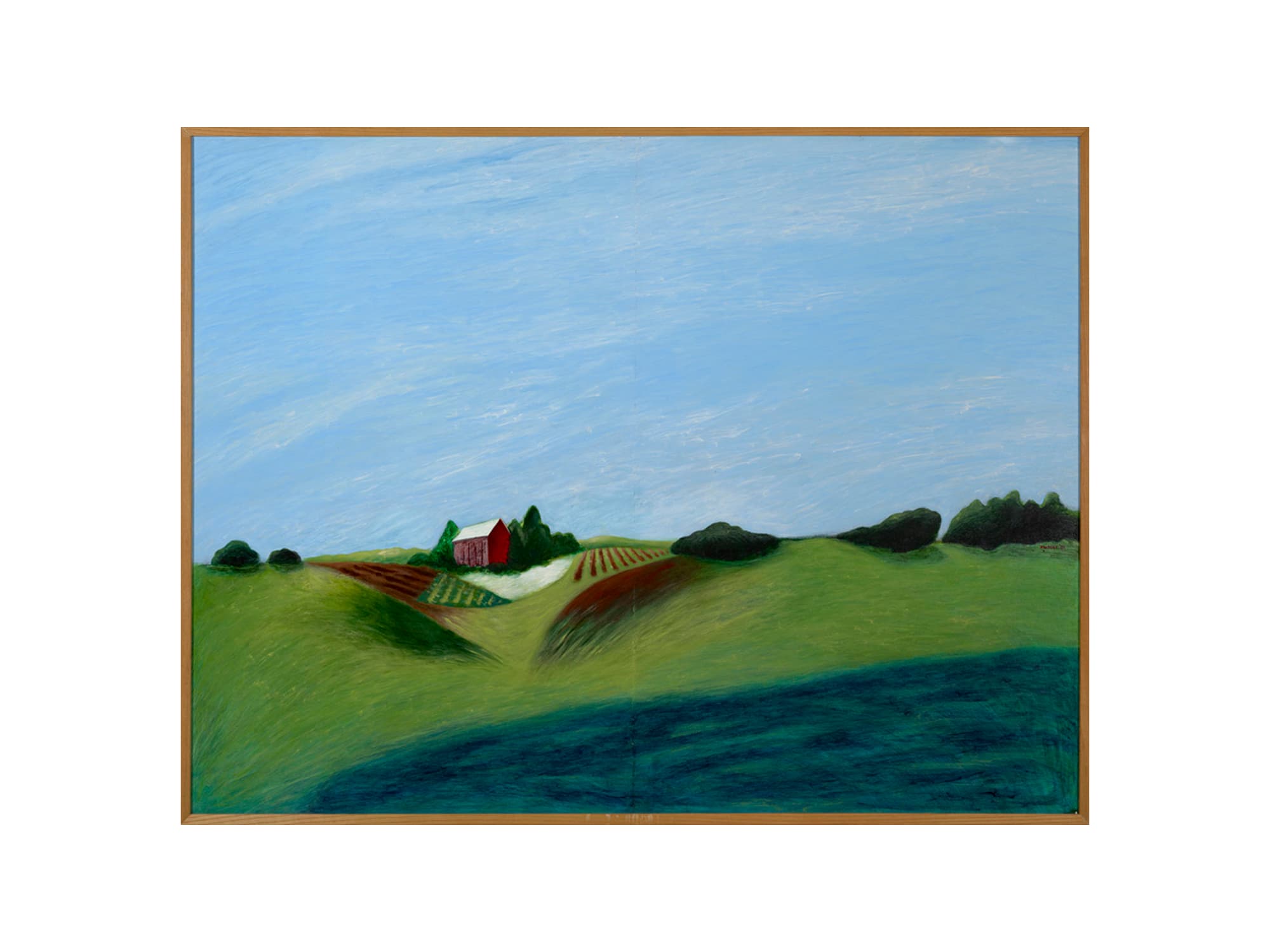
Joseph Muscat
Frontier #44 Ground Break, 1989
Acrylic on paper on board
101.6 x 132 cm
Donated by the artist in 2012
The artist captures the essence of the Canadian frontier through the motif of a solitary cabin, symbolizing human presence in the pristine wilderness. This geometric structure, set in a bucolic landscape, represents the spirit of the frontier and the artist’s vision of Canadian identity.
Artist’s statement: In 1989, I took a long journey by train right up to Moosonee at the lower end of James Bay. I was always curious about the very far northern reaches of Ontario and this trip not only satisfied my curiosity but overwhelmed me with images. One particular visual image was that of the cabin, a symbol of human presence in this pristine wilderness and of the spirit of the frontier within so many of Ontario’s people. This motif of the lonely cabin was to become the single most predominant visual impression of my entire repertoire as an artist. This geometric, solid looking structure became a totemic representation of what I feel to be Canadian. In Frontier #44, Ground Break, the stoic cabin sits in a bucolic and idyllic setting, surrounded by crops and trees basking in the short-lived summer sun.

Charles Pachter
The Painted Flag
Acrylic on canvas
80 x 80 cm
Gift of the Artist
“In 1980 I began painting our Maple Leaf flag billowing under the influence of wind and light. It was the beginning of a romantic attachment to a familiar image that has lasted for decades. Variations on a Theme would be an appropriate way to describe the visual high I continue to get from painting our wonderful flag.”
– Charles Pachter
Note About the Artist: Charles Pachter is a much-admired Canadian artistic polymath, his colourful work merging playful even irreverent elements with deeply iconic imagery. A painter, printmaker, sculptor, designer and author, Pachter is a graduate of the University of Toronto and the Sorbonne-Paris. He is an Officer of the prestigious Order of Canada, a Chevalier of France’s Ordre des Arts et des Lettres, and twice a recipient of the Queen’s Jubilee medal. He has honorary doctorate degrees from the Ontario College of Art & Design, the University of Toronto and Brock University. His paintings are in public and private collections around the world.
You must be logged in to post a comment.